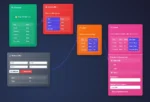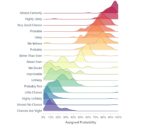
by tyler garrett | Jun 12, 2025 | Data Visual
Imagine your hybrid data workloads as a symphony orchestra—each instrument valuable on its own, but truly transformative only when harmonized by the conductor. In the music of modern analytics, your data strategy serves as the conductor, managing diverse data sources, formats, and flows. Yet, today’s decision-makers grapple with data sprawls across multiple environments, from cloud platforms and on-premises warehouses to SaaS applications and more. Enter data fabric visualization, the conductor’s baton that stitches hybrid workloads into cohesive, insightful symphonies. In this article, we’ll explore how data fabric visualization strengthens data connectivity across heterogeneous environments, offering clear pathways for businesses to orchestrate insights seamlessly, accurately, and reliably.
A Visionary Approach: Understanding Data Fabrics
A data fabric stands as a strategic architectural concept aimed at simplifying data management complexities that inevitably arise in hybrid or multi-cloud environments. In short, the data fabric approach unifies disparate data sources and makes them accessible via a unified and consistent data management framework. At the heart of a data fabric lies automation, integration capabilities, metadata management, governance, and semantic enrichment—key ingredients that empower businesses to turn raw data into actionable insights.
But simply setting up a data fabric isn’t the endgame; visualizing these complex, interconnected data pipelines brings true clarity and power. Effective visualization allows stakeholders not only to see precisely where data resides and how it moves, but also to unlock strategic value in their data assets. By stitching the data fabric with visual clarity, stakeholders across the organization—from business executives to technical teams—can confidently navigate and understand data flows, ensuring that crucial business decisions are based on accurate, timely insights.
Without visualization, even the strongest data fabrics risk becoming opaque silos that obscure rather than illuminate. Indeed, organizations that neglect visualization may suffer increased confusion, slower response times, and limited agility. By embracing visualization, however, businesses reduce operational friction, increase stakeholder confidence, and gain strategic clarity on their data journeys. In short, robust data fabric visualization becomes the bridge that seamlessly connects technical capability to strategic business outcomes.
The Power of Visualization in Managing Hybrid Workloads
“Seeing is believing” could not ring truer in the realm of data management and analytics. Complex hybrid workloads, which might span thousands of distinct sources ranging from cloud services to legacy systems, require robust visualization capabilities to ensure clarity and coherence. Indeed, a well-designed visualization approach can transform daunting data landscapes into clear, understandable interactive visual aids grounding decision-makers with confidence.
One powerful example comes from parallel sets for categorical data flow visualization, which provides a dynamic means to trace connections across disparate datasets seamlessly. Techniques like parallel sets offer intuitively visual depictions of categorical data, enabling stakeholders to quickly grasp how data moves across business domains and identify bottlenecks or anomalies.
Similarly, revolutionary methods like holographic data modeling for multi-perspective analytics strengthen capabilities even further. These advanced visualization methodologies facilitate viewing multidimensional data from numerous perspectives. Stakeholders can immerse themselves in the data fabric and slice through millions of rows and data sources from unique angles, fostering deeper analytical insights. Combined with a strong data fabric infrastructure, businesses gain an unparalleled competitive edge, consolidating diverse workloads into an intuitive blueprint of understanding.
Ensuring Data Consistency: The Importance of Idempotency and Visualization
While visualization excels at highlighting the connections across your data fabric architecture, ensuring accuracy and consistency behind these visuals is critical. This is where the principle and practice of idempotent data transformations become tremendously important. By implementing idempotent operations, your data engineers can execute and re-execute transformations without ever corrupting or compromising data integrity.
Why visualize data processes without first guaranteeing trusted data outcomes? By embedding idempotency within your data fabric architecture, you’re able to reliably handle retries, manage failures better, and streamline continuous integration processes. This robust foundation of confidence, in conjunction with visualization, empowers your stakeholders to optimize hybrid workload performance more efficiently and identify potential issues at a glance.
Additionally, visuals illustrating data integrity checkpoints and idempotent logic help internal teams better understand complex data workflows. With a clear visualization of idempotent checkpoints and error handling, even non-technical leadership can easily grasp how their hybrid workloads prevent inaccuracies, avoid redundancies, and maintain clean data hygiene over time. This transparency fosters increased trust in your data fabric architecture, driving stronger organizational buy-in and ultimately delivering transformative business results.
Harnessing API Integration with the Data Fabric Visualization
Integrating Applications Program Interfaces (APIs) into hybrid workloads can significantly elevate the efficacy of a data fabric across distributed systems. APIs enable connections between previously disconnected data sources and allow your visualization layer to accurately reflect real-time source systems. If APIs intimidate or confuse your team, an extensive resource guide such as our comprehensive API guide for everyone delivers step-by-step instructions that make complex connections easy.
Leveraging APIs within your data fabric architecture enriches your visualization effectiveness. Real-time updates from various API sources, whether internal databases, cloud providers, or third-party SaaS solutions, reflect accurate, timely intelligence across visual dashboards. For instance, your sales team could have APIs configured to visualize critical CRM data alongside supplier and inventory data. Likewise, internal operational teams, empowered with API-driven visual insights, can identify bottlenecks promptly and optimize processes accordingly.
Moreover, a carefully managed API strategy helps ensure heightened security and governance throughout your data workflows. APIs set clear boundaries for internal and external data flows, incorporating proper access controls and authentication mechanisms. With APIs strategically visualized and documented, leaders have holistic transparency—helping them swiftly make informed business decisions with increased trust and agility.
Navigating Common Data Visualization Challenges with Proven Techniques
Despite advantages, attempts to visualize hybrid workloads frequently encounter hurdles. Whether it’s limitations like data size constraints—such as those explained in “connecting to Google Sheets exceeding 10 MB“—or challenges in performance optimization, selecting proper visualization strategies is crucial. Being aware of common pitfalls such as visualization clutter, poor readability, and data scalability limitations enables effective preemptive planning.
Your organization’s visualization approach should integrate best practices explained in “the importance of data visualization in data science“. Emphasis on clarity, simplicity, and focusing on relevant KPIs makes visuals easily interpretable for leaders across all departments. Implementing advanced filtering criteria, optimized visuals, and tightly linked navigational structures are just a few proven methods that can tackle complex environments seamlessly while maintaining optimal user experience.
Working alongside experienced data visualization and analytics consultants can further accelerate overcoming challenges and ensure successful project outcomes. Experts equipped with deep knowledge and best practices can smoothly navigate complex visualization requirements, clarify ambiguity, and ensure impactful, user-friendly designs. Experienced data consultants, such as the experts available through Dev3lop’s trusted MySQL consulting services, consistently help enterprises reach visualization excellence and drive results-oriented analytics programs.
Final Thoughts: Seamlessly Stitching Your Data Fabric Visualization
In today’s data-driven business world, data fabric visualization is no longer optional; it’s foundational to driving strategic advantage. By proactively visualizing hybrid workloads, embracing advanced analytics and modeling techniques, and applying best practices to API integration and idempotency, your organization can unlock deeper accuracy, agility, and confidence from its data fabric architecture.
Like an orchestra’s conductor commanding refinement and clarity, your visualization efforts orchestrate complex, diversified data processes. This produces powerful data storytelling that clearly communicates nuanced insights, enabling your stakeholders to engage effectively with analytics at every turn. Ready to conduct your enterprise’s analytics symphony? Now’s the time to stitch those hybrid workloads into the cohesive visualization tapestry driving extraordinary organizational effectiveness.
Thank you for your support, follow DEV3LOPCOM, LLC on LinkedIn and YouTube.

by tyler garrett | Jun 11, 2025 | Data Visual
The exponential surge in data volume is transforming how businesses strategize, compete, and innovate. Today, capturing insights in real-time has shifted from being a nice-to-have capability to a critical necessity. The conventional model of centralized analytics, sending data from its source to distant cloud servers, encounters inevitable bottlenecks and latency issues. As digital complexity grows, decision-makers must embrace faster and smarter ways to visualize data directly at its origin. Enter edge computing visualization—a groundbreaking approach that leverages decentralized processing power and localized analytics to render actionable insights precisely where data originates. In this blog, we’ll show you why edge computing visualization should be on your radar, outlining its strategic importance in reshaping data analytics paradigms and providing practical insights your business can leverage immediately.
What Exactly is Edge Computing Visualization?
At its core, edge computing visualization combines two powerful technology trends: edge computing and advanced data visualization. Edge computing refers to performing data analytics, storage, and computation close to where data is generated—at IoT devices, industrial machinery, sensors, and network gateways. Here, visualization occurs at this same edge tier, providing real-time analytic insights immediately as data emerges from these remote points.
This localized visualization strategy contrasts starkly to traditional centralized visualization models. Instead of sending data to the cloud, potentially hundreds or thousands of miles away, businesses now render innovative visualizations instantly on-site or at nearby regional nodes. The closer the visualization is to the point of origin, the faster teams can respond to real-time scenarios and make data-driven decisions efficiently. Considering the need for timely decision-making in mission-critical domains like manufacturing, healthcare, finance, or transportation, minimizing latency becomes a powerful competitive advantage. Leveraging edge computing visualization therefore helps mitigate traditional network-related bottlenecks, ensuring performance excellence under dynamic operating conditions.
Moreover, edge visualization methodologies drive enhanced data management capabilities. Implementing semantic layer optimization for multi-dimensional analysis assists businesses in transforming raw data points into meaningful, context-rich insights instantly, directly at the edge.
The Strategic Advantages: Why Add Edge Visualization to your Data Analytics Arsenal?
Minimized Latency for Rapid Decision-Making
Each millisecond counts in modern business analytics. While centralized cloud visualization introduces transmission delays, edge computing visualization significantly reduces latency, providing near-instantaneous insight. Real-time analytics improve decision-making considerably—particularly where operational speed translates into revenue, safety, or immediate operational effectiveness. For instance, manufacturers can proactively visualize and correct equipment malfunctions seconds after noticing anomalies on the assembly line instead of hours later. Similarly, healthcare providers can visualize critical patient data immediately, promptly triggering timely interventions to save lives.
By adopting edge visualization, organizations gain improved responsiveness and agility. As an advanced analytics consulting services provider, our team has seen firsthand how implementing systems closer to data generation dramatically enhances business capabilities. This strategic shift empowers companies to maintain control directly at source, using rapid visualization insights to solidify competitive advantages and respond dynamically to changing business landscapes.
Improved Data Security and Compliance
Data breaches have become increasingly prevalent, underscoring the importance of security and compliance throughout the data lifecycle. Traditional visualization paradigms, relying heavily on cloud-based data transfers and centralized databases, heighten the risks associated with data transit and centralized storage. Edge computing visualization effectively mitigates these risks by performing analytics and rendering directly where data originates, reducing unnecessary cross-network exchanges and safeguarding sensitive data.
Adopting edge-based visualizations also aligns well with regulatory frameworks addressing data privacy and governance, reducing compliance risks. A sophisticated methodology, such as our proven data deletion verification and certification process, complements edge computing visualization approaches, bolstering regulatory adherence and ensuring businesses effectively oversee data management directly at the data source.
Practical Applications and Real-World Use Cases
Manufacturing and Industry 4.0
In manufacturing, production lines equipped with IoT sensors generate copious amounts of operational data. Edge computing visualization enables teams to capture immediate insights around equipment health, utilization rates, and product quality directly on the shop floor. Presenting insightful dashboards instantly at the edge empowers staff to identify anomalies early, improving efficiency and productivity while reducing potential downtime from device or process failures.
For example, utilizing accurate demand prediction and precise forecasting analytics, factories dynamically visualize real-time forecasts close to their generation points. Here, edge visualization not only enhances operational effectiveness but also drives unmatched competitive differentiation in today’s hyper-connected industrial environments.
Smart Cities and IoT Implementations
The infrastructure of tomorrow demands sophisticated handling of real-time data flows. Smart cities—leveraging IoT device networks consisting of city sensors, cameras, and traffic management systems—find enormous value in edge visualization. City officials can quickly visualize traffic, environmental conditions, or emergency service availability without sending data back and forth to distant data centers. Real-time data rendering at the edge boosts efficiency in public services and emergency response.
Implementing schema evolution patterns with backward and forward compatibility also helps urban environments continuously adapt their analytical frameworks with evolving data, ensuring seamless integration of future-proof solutions alongside edge visualization technologies.
Technical Considerations: Making Edge Computing Visualization a Reality
Infrastructure and Resource Optimization
Deploying edge computing visualization requires careful infrastructure planning. Organizations must consider the optimal equipment for edge environments, including strategically placed compute and storage resources. Efficient caching, low-latency communication pathways, and fault-tolerant architecture allow businesses to maintain stable edge visualization operations without compromising reliability and robustness in real-world conditions.
Moreover, companies can enhance efficiency by introducing innovative concepts, like recursive materialized view patterns for efficient analytics hierarchies, helping edge computing nodes maintain consistently strong analytical performance despite resource constraints.
Complexity in Data Management and Schema Evolution
Edge visualization introduces new considerations for data management, including maintaining synchronized data schema and versioning across decentralized deployments. Implementing intelligent temporal tables and querying data through time efficiently at the edge enables organizations to effectively track evolving data schema and visualization configurations across distributed edge points.
This is critical for businesses striving to keep their analytical frameworks scalable, interoperable, and backward-compatible, especially as device ecosystems and edge deployments expand rapidly. Prioritizing strong strategies upfront in schema evolution and ongoing optimization ensures edge computing visualization implementations remain manageable and capable of accommodating future needs without extensive rearchitecting.
Edge Visualization Strategy: The Competitive Imperative for Data-Driven Organizations
The writing is on the wall—edge computing visualization represents the next evolutionary step in analytics capabilities for modern digitally-driven businesses. As industries race toward IoT integrations, next-generation connectivity, and real-time analytics frameworks, organizations must position themselves at the vanguard of data visualization technologies.
By proactively investing in edge computing visualization, businesses not only bolster their competitiveness today—they also lay critical groundwork for innovation tomorrow. Companies struggling with common analytics barriers can benefit greatly by checking out our resource on how to fix a failing dashboard strategy with creative insights and using it as a complementary guide in seamlessly integrating edge analytics visualization strategies.
Don’t merely survive in your industry; dominate by harnessing the power and potential of edge computing visualization. By making analytics instant, insightful, agile, and secure, your organization can elevate its performance dramatically—all while delivering consistent value throughout your digital ecosystem.
Thank you for your support, follow DEV3LOPCOM, LLC on LinkedIn and YouTube.

by tyler garrett | Jun 9, 2025 | Data Processing
Imagine your analytics system as a tightly choreographed dance performance. Every performer (data event) needs to enter the stage precisely on cue. But real-world data seldom obeys our neatly timed schedules. Late-arriving data, events that report well beyond their expected window, can cause significant bottlenecks, inaccuracies, and frustration – complicating decisions and potentially derailing initiatives reliant on precise insights. In an ever-evolving digital age, with businesses leaning heavily on real-time, predictive analytics for critical decision-making, your capability to effectively handle late-arriving events becomes pivotal. How can your team mitigate this issue? How can your company reliably harness value from temporal data despite delays? As experts who help clients navigate complex data challenges—from advanced analytics to sophisticated predictive modeling—our aim is to maintain clarity amidst the chaos. Let’s dive into proven strategic methods, useful tools, and best practices for processing temporal data effectively, even when events show up fashionably late.
Understanding the Impact of Late-Arriving Events on Analytics
Late-arriving events are a common phenomenon in data-driven businesses. These events occur when data points or metrics, intended to be part of a chronological timeline, are received much later than their established expectation or deadline. This delay may stem from a lot of reasons—connectivity latency, slow sensor communication, third-party API delays, or batch processes designed to run at predetermined intervals. Whatever the origin, understanding the impact of these delayed events on your analytics initiatives is crucially important.
Ignoring or mishandling this late-arriving data can lead decision-makers astray, resulting in inaccurate reports and analytics outcomes that adversely influence your business decisions. Metrics such as customer engagement, real-time personalized offers, churn rate predictions, or even sophisticated predictive models could lose accuracy and reliability, misguiding strategic decisions and budget allocations.
For example, suppose your business implements predictive models designed to analyze customer behaviors based on sequential events. An event’s delay—even by minutes—can lead to models constructing incorrect narratives about the user’s journey. Real-world businesses risk monetary loss, damaged relationships with customers, or missed revenue opportunities from inaccurate analytics.
Clearly, any analytics practice built upon temporal accuracy needs a proactive strategy. At our consulting firm, clients often face challenges like these; understanding exactly how delays impact analytical processes empowers them to implement critical solutions such as improved data infrastructure scalability and real-time analytics practices.
Key Strategies to Handle Late-Arriving Temporal Data
Establish Effective Data Windows and Buffer Periods
Setting up clearly defined temporal windows and buffer times acts as an immediate defensive measure to prevent late-arriving data from upsetting your critical analytical computations. By carefully calibrating the expected maximum possible delay for your dataset, you effectively ensure completeness before initiating costly analytical computations or predictive analyses.
For instance, let’s say your dataset typically arrives in real-time but occasionally encounters external delays. Defining a specific latency threshold or “buffer period” (e.g., 30 minutes) allows you to hold off event-driven workflows just long enough to accept typical late contributions. This controlled approach balances real-time responsiveness with analytical accuracy.
By intelligently architecting buffer periods, you develop reasonable and robust pipelines resilient against unpredictable delays, as described in-depth through our guide on moving from gut feelings to predictive models. Once established, timely, accurate insights provide better decision support, ensuring forecasts and analytical processes remain trustworthy and reliable despite the underlying complexity of data arrival timings.
Leverage Event Time and Processing Time Analytics Paradigms
Two important paradigms that support your strategic approach when addressing temporal data are event-time and processing-time analytics. Event-time analytics organizes and analyzes data based on when events actually occurred, rather than when they are received or categorized. Processing-time, conversely, focuses strictly on when data becomes known to your system.
When late-arriving events are common, relying solely on processing-time could lead your analytics frameworks to produce skewed reports. However, shifting to event-time analytics allows your frameworks to maintain consistency in historical reports, recognizing the occurrence order irrespective of arrival delays. Event-time analytics offers critically important alignment in analytics tasks, especially for predictive modeling or customer journey analyses.
Our company’s advanced analytics consulting services focus on guiding businesses through exactly these complex temporality issues, helping decision-makers grasp the strategic importance of this event vs. processing time distinction. Implementing this paradigm shift isn’t just optimal—it empowers your business to derive maximum accurate insight even when previous late events show up unexpectedly.
Essential Data Engineering Practices to Manage Late Data
Augmenting the Data Processing Pipeline
Developing an efficient, fault-tolerant data processing pipeline is foundational to proactively managing late-arriving events. A critical first step is ensuring your data ingestion pipeline supports rapid scalability and real-time or near-real-time streaming capability. By adopting scalable persistence layers and robust checkpointing capabilities, you preserve the capability to seamlessly integrate late-arriving temporal data into analytical computations without losing accuracy.
Leveraging a reliable SQL infrastructure for querying and analyzing temporal data also becomes vital. Our expertise includes helping clients understand core database concepts through our comprehensive tutorials, such as the resource on SQL syntax best practices, optimizing efficiency in managing complex real-time and historical data.
Additionally, employing architectures such as Lambda and Kappa architectures enables your organization to seamlessly manage fast streaming and batch data processes while effectively handling late data arrivals. These paradigms, emphasizing scalable and reliable pipelines, ensure significant reductions in processing bottlenecks generated by delayed inputs, ultimately positioning you firmly at the forefront of analytics effectiveness.
Semantic Type Recognition and Automation
Embracing semantic understanding simplifies the robust application of automation within your data processing framework. Semantic type recognition helps your system automatically determine how best to interpret, sort, restructure, and intelligently reprocess late-arriving temporal events. As explained in our piece on automated semantic type recognition, this capability can dramatically reduce human intervention, boosting the efficiency of your analytics workflows.
Semantic automation also enables reliable integration of identity graphs optimized for holistic customer insights. Our consulting teams have recommended strongly to businesses the robust potential of identity graph construction, ensuring enterprises can seamlessly manage late-arriving customer event data to achieve clearer analytical insights and optimized marketing strategies.
Integrating semantic automation proactively mitigates the inherent chaos caused by late event data, strengthening your analytics framework and improving overall data confidence tenfold.
Advanced Visualization and Reporting Techniques for Late Data
Effective visualization techniques enhance clarity, particularly when managing complex temporal datasets with late-arriving events. Applying interactive, hierarchical visualization techniques like Voronoi Treemaps provides innovative approaches capable of dynamically adjusting visualizations as new events or adjustments emerge. These visual approaches ensure a crystal-clear understanding of data distribution, event timing, and interdependencies, even when data arrival times differ.
Advanced visualization techniques not only help your data analysts and stakeholders quickly comprehend and act upon insights from complex temporal data—they also ensure your team regularly anticipates unexpected data adjustments, strategically incorporating them within targeted analytical results. Coupled with proactive reporting indicators built-in to dashboards, your team navigates late data transparently, minimizing uncertainty and maximizing productivity and insight.
Visualization, reporting, and dashboarding strategies backed by solid understanding and creative processes allow your organization to extract genuine value from temporal analytics, positioning your business powerfully ahead in strategic data decision-making.
Positioning Your Business for Success with Late-Arriving Data

by tyler garrett | Jun 7, 2025 | Data Processing
In a bustling digital economy, data fuels business innovation, decision-making, and competitive advantage. Yet amidst the vast streams of data collected daily, duplicate records silently inflate quality risks, distort analytics, and escalate operational inefficiencies. To maintain robust data health and reliable insights, organizations require scalable solutions to accurately identify and address duplicates. Enter data fingerprinting—the sophisticated yet practical methodology for efficiently detecting duplicate records at massive scales. In this blog, we explore the art of data fingerprinting, highlighting strategic approaches, cutting-edge techniques, and real-world applications that help organizations ensure data quality, accuracy, and clarity in decision-making processes.
Understanding the Essential Role of Data Fingerprinting
Data fingerprinting is an innovative methodology used to uniquely identify and verify data objects by generating concise, representative signatures—often known as “fingerprints.” Each fingerprint, typically produced through hashing algorithms or leveraging specific sets of features from the data, acts as a unique identifier. Businesses employ fingerprints for rapid recognition of duplicates and effective data validation, fundamentally improving the integrity of analysis and the accuracy of business intelligence.
Detecting duplicate records through fingerprinting becomes indispensable as data systems grow increasingly complex, distributed, and heterogeneous. Without reliable deduplication approaches in place, insights drawn from data analytics are susceptible to inaccuracies, potentially leading to misguided decisions. Techniques like data fingerprinting provide streamlined and automated ways to consistently maintain data authenticity—facilitating a strong foundation for precision-driven analytics.
At its core, data fingerprinting complements other essential strategies like multi-stage data validation by augmenting rules-based checks with a more granular verification layer. By efficiently identifying duplicate entries at scale, companies reap increased trustworthiness in analytical dashboards, improved user experiences, and significantly reduced manual verification overheads.
The Mechanics Behind Data Fingerprinting
Hashing-Based Fingerprinting Methods
A fundamental method for data fingerprinting is using cryptographic hash functions such as MD5, SHA-256, and MurmurHash. These functions take inputs of varying lengths, including long strings or file binaries, and output fixed length, unique-looking representations. Due to their efficiency in computation, hashing methods become ideal for detecting duplicate records across massive data sets and diverse data sources. Hash algorithms ensure identical strings produce identical fingerprints, reigning in the identification power necessary to manage data integrity.
Choosing a hashing method requires understanding your data volume, performance trade-offs, and collision rates. Although uncommon, collisions—instances where two distinct records generate the same fingerprint—can occur even with robust hashing algorithms. Selecting appropriate hashing techniques mitigates risks of collision errors and ensures fingerprinting accuracy and consistency.
Feature-Based Fingerprinting Approaches
For some data types, especially textual content, hashing alone might be insufficient. Feature-based methods combine multiple attributes or data fields into composite identifiers or semantic signatures. Utilizing tokenization and processing algorithms for content comparison, these methods enrich fingerprint diversity and match accuracy. Leveraging advanced semantic analysis and comparison methodologies—discussed in our recent article on semantic layer optimization—enables users to validate similarity at granular levels, augmenting the effectiveness of duplicate detection.
When employed smartly and consistently, these two fingerprinting techniques collectively deliver robust solutions that identify records with enhanced granularity, accuracy, and speed, making them indispensable for large-scale data environments.
Scaling Data Fingerprinting: Solving Big Data Challenges
As businesses increasingly embrace Big Data solutions, fingerprinting techniques must scale efficiently to handle billions of data points, real-time data streams, and distributed computing environments. Modern data fingerprinting solutions harness scalable analytics platforms, distributed database architectures, and sophisticated data processing frameworks that integrate seamlessly with existing infrastructure.
Organizations looking to scale effectively might consider leveraging process automation and platform orchestration tools—such as Airflow, Prefect, or Dagster—to coordinate the execution of fingerprinting tasks at scale. We provided deep insights into each tool’s strengths and trade-offs in our comparative analysis of pipeline orchestration strategies. With these tools, fingerprinting tasks become streamlined, repeatable, and automatically maintain data accurately and efficiently.
Real-time fingerprinting, particularly critical in applications requiring immediate data verification, often leverages advanced dynamic window computation models. Implementing these approaches supports businesses in continuously monitoring duplicate data entries as they stream into data systems, offering near-instantaneous insights into data health and accuracy. Successful large-scale fingerprinting implementations hinge upon choosing scalable algorithms and architectures that align closely with an organization’s existing technologies and future growth strategies.
Utilizing Fingerprinting for Advanced Data Validation and Metric Accuracy
Incorporating fingerprinting seamlessly complements and enhances other validation strategies, like metric drift detection, delivering multifaceted data quality assurance mechanisms. For complex enterprises, a structured data governance model, as explored in our methodologies about how to establish an enterprise canonical data model, becomes foundational. Fingerprints can seamlessly integrate into such structured data models, validating and facilitating accurate communication of common data in distributed systems.
Moreover, data fingerprinting supports sophisticated interactive approaches like crossfiltering techniques used in multi-chart dashboards. Ensuring data uniqueness and cleanliness through early-stage fingerprinting translates into clearer, intuitive dashboards—driving optimized user experiences and sound analytical interpretations. Ultimately, by embedding fingerprinting strategically into data systems, organizations promote reliable insights and effective decision-making across all business domains.
Overcoming Common Challenges in Fingerprinting Implementation
Data fingerprinting implementation presents several noteworthy challenges that must be navigated strategically. Addressing operational overheads, accommodating evolving data structures, and managing computational costs demand careful management. Successful practitioners emphasize deploying precise fingerprinting techniques aligned directly to their unique business environments, focusing clearly on data characteristic identification and aligned performance objectives.
One recognized concern is managing computational resources efficiently, especially when handling large data volumes. Companies should perform systematic comparative analysis of ETL solutions to understand performance impact and budget optimization. Similarly salient: avoiding ‘analysis paralysis’ and ‘chart junk’ by ensuring data quality through fingerprinting procedures—a concept we’ve thoroughly outlined in our previous assessment of chart junk removal. Removing data redundancies and inaccuracies further refines analytics and interpretation capabilities, aligning data-driven outcomes to strategic business priorities.
Effective fingerprinting demands continuous reflection, data validation evaluations, and adjustment processes. Partnering with experienced consultants, such as Dev3lop’s data visualization consulting team, supports organizations by providing strategic advice and technical expertise needed to overcome digital fingerprinting barriers quickly and effectively.
Aligning Fingerprinting Strategy with Emerging Technologies
As artificial intelligence and machine learning technologies mature at exponential speeds, fingerprinting techniques broaden, evolve, and adopt forward-thinking innovations. As covered in our recent case studies and overview of real-world AI business applications, machine learning-driven fingerprinting separates subtle duplicates that simple hashing algorithms may overlook.
In rapidly changing environments where traditional fingerprinting methods face limitations, organizations can benefit from employing intelligent systems that continually adapt fingerprints through pattern recognition, robust analytics, and semantic technologies. Investing into such advancements provides increased accuracy, enriched data understanding, and amplified competitive advantage derived from higher-quality analytical conclusions and more effective business strategies.
Ultimately, effective data fingerprinting positions the modern organization as not merely reactive but strategically proactive and resilient—prepared through innovation to thrive in competitive, data-driven landscapes.

by tyler garrett | Jun 2, 2025 | Data Management
The pace of digital transformation brings agility, flexibility, and powerful analytics capabilities into the heart of business strategies. Yet, with insightful analytics comes inevitable upstream schema changes that could disrupt your organization’s data operations. Whether due to new business requirements, system improvements, or regulatory demands, schema changes are constant—but managing them doesn’t have to be daunting. Impact analysis automation is an indispensable strategy enabling decision-makers to swiftly identify, analyze, and manage ripple effects of these upstream schema modifications. By understanding and systematically controlling these changes, organizations can safeguard their analytics architectures, maintain uninterrupted operations, and drive robust adoption of data visualization solutions critical to actionable insights. In this article, we explore how automating your impact analysis empowers your organization to turn schema changes from unexpected hurdles into predictable, manageable steps in your data journey.
Understanding Schema Changes and Why They Matter
In the modern enterprise ecosystem, schemas act as blueprints that define how data is structured, stored, and ultimately consumed by analytics teams. Upstream schema alterations in source systems may range from modest adjustments, such as renaming database columns or recalibrating data types, to extensive structural overhauls with significant downstream repercussions. Executives and technology strategists need clear visibility into how schema adjustments impact workflows, reporting, dashboards, and analytics engines—especially when critical decisions hinge on data accuracy and availability.
Misaligned data schemas can significantly distort analytical results, compromising business intelligence processes, predictive analytics, and comparative analyses. Without proactive impact monitoring, analytics stakeholders might unwittingly base strategic decisions on incomplete or incorrect information. Organizations leveraging data-driven business strategies cannot afford such setbacks. Robust impact analysis automation helps pinpoint precisely where changes cascade through interconnected processes, visualizations, ETL pipelines, and data models. These automated tools illuminate risks early, averting costly failures and operational upheavals often overlooked by manual analysis methods.
Unpacking the Challenges: Manual Impact Analysis
While change management is recognized as essential, traditional manual impact analysis remains daunting and error-prone. Human analysts often spend countless hours scrutinizing data lineage and manually tracing source attributes across diverse systems and reports to understand schema changes. Such manual efforts, while thorough, suffer from key limitations like human error, intense resource dependency, and the inability to scale effectively in large enterprise environments.
Manual assessments result in delayed decisions, slowed projects, and missed opportunities; these consequences could hamper the agility organizations strive for. Furthermore, as businesses increasingly integrate cloud solutions, APIs, and sophisticated visualization tools—including tools recommended by data visualization consulting experts—manual change tracking significantly inhibits rapid innovation.
Without automated capabilities, data platform teams struggle to maintain consistency in understanding upstream-downstream dependencies, resulting in reactive rather than proactive interventions. These limitations jeopardize predictive and prescriptive analytics initiatives—capabilities described extensively in our piece on types of data analytics. Consequently, executives seeking predictive insights and competitive advantages risk proceeding without accurate visibility into underlying data structure shifts.
The Business Case for Automating Impact Analysis
Automating impact analysis significantly bolsters data-agility, operational intelligence, and strategic resilience across industries and use-cases. Running schemas through automated lineage-tracking technologies helps swiftly visualize changes’ impact, giving analysts and executives clear visibility into business-critical reports and dashboards affected by upstream modifications.
This strategic visibility directly translates into measurable value. Leading organizations adopting automated impact analysis report improved report accuracy, drastically reduced time to remediate schema-related issues, and optimized resource allocation towards innovative, rather than reactive, initiatives. Companies can proactively manage upcoming changes, avoiding costly downtime and enabling nimbleness for rapid API implementations, new analytics dashboards, and innovation-driven business initiatives.
Furthermore, automating impact detection promotes better collaboration across data governance and transformation teams, clearly delineating responsibilities and speeding solution deployment. Whether your organization focuses on financial analytics, marketing scenarios, or even public-sector effectiveness such as initiatives described in our article on data analytics improving public services, automation drives quality assurance, boosts strategic effectiveness, and ensures more deliberate schema changes—minimizing costly disruptions.
Essential Capabilities for Effective Impact Analysis Automation Tools
To reap full benefits of automating schema impact analysis, organizations need sophisticated tools tailored to modern analytics landscapes. Critical capabilities include comprehensive data lineage tracing, dynamic dependency mapping, notification-based alerting, and version control integration. Today’s enterprises thrive when platforms offer readily accessible visualizations capable of presenting datasets clearly—for instance, employing visual analytics patterns such as those described in small multiple design patterns for comparative analysis.
Effective automation tools go beyond simple dependency mapping; they predictively pinpoint potential bottlenecks, risks of data quality erosion, and impending issues affecting data integrity. Additionally, sophisticated reporting and visualization capabilities offer executives and analytics leaders user-friendly, reality-based insight into ongoing schema impacts. Organizations seeking enhanced agility should look for platforms offering flexible integrations, accommodating widely used data warehouses, BI tools, analytical applications, and CI/CD tooling.
With seamless integration into enterprise analytics stacks, these automation platforms enable data stewards, analysts, and decision-makers to proactively strategize rather than reactively troubleshoot. From comprehensive lineage analysis to strategic-ready visual alerts, effective automation transforms business continuity, fosters speed to business insights, and saves significant resources by reducing costly rework.
Establishing Change Management Best Practices for Schema Impact Automation
While an impact analysis automation platform adds substantial value, it must integrate into broader organizational change management frameworks to have maximum effectiveness. Decision-makers should institute clear guidelines for communicating planned schema alterations, ensuring consistent documentation across various data sources and processes. Utilizing version-controlled repositories for change histories helps your teams implement sustainable schema evolution practices, safeguarding analytics and dashboard investments.
Moreover, leaders should regularly validate the automated impact assessment systems, verifying results, and continuously optimizing response strategies to emerging schema changes. Aligning automation with strategic transformation projects fosters higher team engagement and encourages informed participation, ultimately leading toward analytic maturity and resilience across the data lifecycle.
An automation-first methodology encourages proactive issue anticipation. Instead of anxiously responding mid-crisis to dashboards providing misleading insights—something explored deeply in our article, “how to kill a dashboard before it kills your strategy”—executives can confidently rely on automated schema impact frameworks, assured of early warnings and prioritized change responses.
The Future of Schema Change Management: Automation as the Standard
Automation is no longer a mere convenience—it is rapidly becoming the standard expectation for any data-intensive enterprise serious about strategic advantage. By implementing an automation-driven rigor in upstream schema impact analysis, businesses and public sector entities alike will elicit unmatched confidence in data solutions and embedded analytics strategies.
As analytics ecosystems become increasingly complex, with interconnected microservices, real-time dashboards, and dynamic predictive models, automation anchors decision visibility and strategy execution. Organizations embracing the power of proactive analytics automation ensure sustained review cycles, actionable alerts, and effective schema-change controls—shifting their teams’ focus from manual fixes to strategic innovation and forward-looking analytics insight.
Ultimately, embedding automation within schema impact analysis marks the decisive step toward a smarter analytics future: transforming schema challenges from disruptive unknowns into opportunities for organizational insight and continuous innovation.
Thank you for your support, follow DEV3LOPCOM, LLC on LinkedIn and YouTube.























